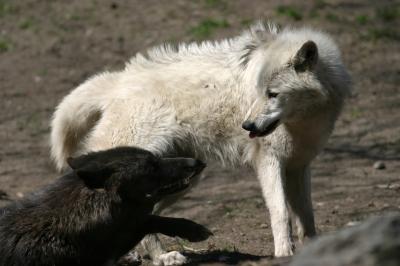The study by Marco Musiani, professor in the U of C's Faculty of Environmental Design, and colleagues used genetic analysis of gray wolf populations from North America and Europe to trace the source of the dominant gene responsible for dark coat color in wolves back to domesticated dogs and concluded the trait was passed to the gray wolf population, as well as to coyotes, by mating between the closely-related wild and domestic canid species. The transition could have taken place as recently as the arrival of European domestic dogs in North America or as long as 14,000 years ago when humans migrated into North America across the Bering Strait.
Since then, black fur has become commonplace in wolf packs, perhaps because snow-covered northern environments are shrinking and darker coloring allows for greater stealth while hunting in areas without snow. While gray wolves can be found in colors ranging from white to gray to black, light-coloration is predominantly found in the arctic tundra where wolves prey on barren ground caribou. The researchers note that the relationship between coat color and habitat is often attributed to adaptation and natural selection, but this is the first example of a genetic modification that likely arose due to human selection becoming adaptive and selected for when back in nature.

Black wolves dominate packs in the forests of North America, while white wolves are more numerous in the treeless tundra. Credit: Marco Musiani, University of Calgary
"Although it happened by accident, black wolves are the first example of wolves being genetically-engineered by people," said Musiani, an internationally-recognized expert on wolves. "Domestication of dogs has led to dark-colored coats in wolves, which has proven to be a valuable trait for wolf populations as their arctic habitat shrinks," Musiani said. "It also shows that human activities can help enrich the genetic diversity of wild animal populations, which is a very unexpected finding.
"I have spent a lot of time in tree-line areas at the southern edge of the tundra and it has always surprised me that there are white wolves and black wolves but no gray wolves in these areas," Musiani said. "This work may provide an explanation: Wolf populations are quickly adapting to conditions with less snow by taking advantage of the human-created shortcut of black coloration."
With tundra habitat expected to decline in coming years due to northern expansion of boreal forests related to global warming, the researchers note that black coloring may also help gray wolves adapt to their changing environment.
"It is somewhat ironic that a trait that was created by humans may now prove to be beneficial for wolves as they deal with human-caused changes to their habitat," Musiani said.
Article: "Molecular and evolutionary history of melanism in North American gray wolves", Science Express
These initial findings will be further studied through a collaborative National Science Foundation Initiative.





Comments